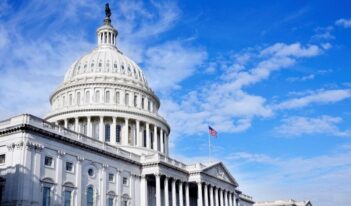
A recent report highlights funding gaps for infrastructure and potential fixes.
Every time you fuel up at the gas pump, you help the federal government fill its coffers. But the 18 cents per gallon tax premium you pay today is the same as 25 years ago, leading to a “revenue dilemma” for transportation agencies.
Taxes on gasoline and diesel fuel fund the majority of the Highway Trust Fund, which supports federal infrastructure spending on roads and bridges. But as a recent Congressional Research Service (CRS) report makes clear, this funding formula is broken, and Highway Trust Fund revenue is falling behind spending needs. In its report, the CRS identifies numerous options for addressing the long-term financial stability of the Highway Trust Fund, including raising the gas tax, expanding the use of tolling, and making general Treasury funds a permanent revenue source.
Today, the vast majority of revenue paid into the Highway Trust Fund comes from federal taxes on gas and diesel. When the Fund was created in 1956, the U.S. Congress imposed a 3 cent per gallon tax on gasoline. Critically, however, Congress did not peg the tax to inflation, so Congress must vote each time it wants to raise the tax. Congress raised the gas tax only four times over the following 40 years, with the last increase in 1993, raising the tax to 18.4 cents per gallon. The gas tax today would be 31.7 cents per gallon if indexed to historical inflation.
But at the current level of 18.4 cents per gallon, the revenue collected under the motor vehicle fuel tax is insufficient to meet infrastructure funding needs. The Congressional Budget Office estimates a shortfall of $95 billion over the next five years between anticipated Highway Trust Fund revenue and current federal infrastructure spending levels. Not only is Highway Trust Fund revenue too low to meet maintenance level spending infrastructure, it falls far short of addressing the nation’s serious infrastructure backlog. For example, it would cost $123 billion alone to fix all of the structurally deficient bridges in America.
Two historical trends help explain why the 18.4 cent gas tax is currently insufficient to support the Highway Trust Fund, according to CRS.
First, vehicle miles traveled (VMT)—a measure of the total miles Americans drive annually—is growing at a slower rate than in previous decades. The Federal Highway Administration expects VMT to increase by only 1.2 percent over the next twenty years. This long-term trend is partly due to the increased emphasis city planners now place on walkability and dense, mixed-use development. Millennials also have far lower car ownership rates, possibly signaling attitudinal shifts away from driving.
Second, advances in technology have made vehicles more fuel efficient, which directly reduces the amount of revenue collected by fuel taxes. When the Highway Trust Fund was created in 1956, the average fuel economy for a passenger vehicle was 14.5 miles per gallon, compared to 23.5 miles per gallon in 2010. Any future expansion in the use of hybrid or electric vehicles would lower gas tax revenues further.
CRS identifies a number of ideas for fixing the federal government’s shortfall in infrastructure funding.
The first would be to raise the gas tax and then index it to either inflation or fuel efficiency. But opponents of an increased gas tax argue that such a tax is regressive and disproportionately impacts the middle class, raising the price of consumer goods and slowing the economy. Furthermore, although raising the gas tax is arguably the fastest way to add more revenue to the Highway Trust Fund, eventually a new approach will again be needed as gasoline is replaced by alternative-fuel vehicles.
A second way to address the funding shortfall would be to expand revenue collected by tolls. With limited exceptions, federal law prohibits states from tolling on roads that receive money from the Highway Trust Fund. Less than 1 percent of such roads are currently tolled, making tolls a major untapped source of revenue. The Trump Administration endorsed lifting the federal tolling restriction in its 2018 infrastructure spending proposal.
But expanding the use of tolling is not a silver bullet. As the CRS report notes, many states do not have roads with sufficient traffic volume to make tolling a viable option for significant funding. Furthermore, tolling is not an efficient collection mechanism. Collection costs often exceed 10 percent of revenue, meaning the government only keeps $0.90 of every dollar it collects. And, like gas taxes, tolls hit lower-income drivers the hardest. Critics say that tolls serve as an additional tax on drivers who are already paying a gas tax.
A final approach would be to appropriate general funds to the Highway Trust Fund. CRS calls this the “de facto” policy for the last twelve years and suggests that doing so on a permanent basis would add stability and predictability for long-term infrastructure investments. Furthermore, CRS points out the public-good justification for funding other transportation investments, like aviation, through the general fund could apply to roads and bridges because the societal benefits of a functioning highway system extend beyond the direct users of that system.
Although drivers in the United States have enjoyed 25 years of lower fuel taxes than their counterparts in many other developed countries, the tradeoff in terms of lower infrastructure quality and safety appears to be catching up. In its report, the CRS makes clear that Congress will need to make difficult choices in the coming years to address the funding shortfall.



